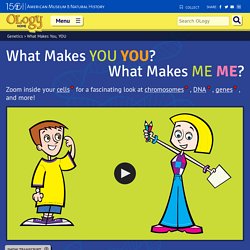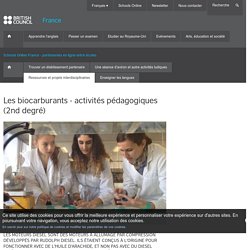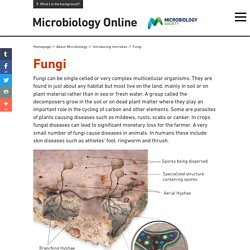

Titration module_final.
L'enseignement technologique en langue vivante - ETLV. Programmes et ressources - voies générale et technologique - ETLV - Bac 2021. MIT 20.020 Introduction to Biological Engineering Design, Spring 2009. Laboratory equipment names and uses - Laboratory glassware names. Lab Equipment - Self Quiz. Lab Tools and Equipment - Know your glassware and become an expert Chemist! List of Laboratory Equipment in English.
A tour of Microbiology Lab (for Freshers) Breathin - Ariana Grande SCIENCE Acapella. Science STYLE Cover - Taylor Swift Acapella Parody. SCIENCE WARS - Acapella Parody. DNA animations by wehi.tv for science-art exhibition. Inside Diabetes. Genetic Disorders. What Makes You, YOU. 150 Years American Museum of Natural History Share OLogy Home search Type keyword(s) to search OLogy Menu ☰ ✕ Games Stories Hands-on Videos Biology Biodiversity Brain Genetics Marine Biology Microbiology PaleontOLogy Zoology Human Cultures Anthropology Archaeology Earth & Space Astronomy Climate Change Earth Physics Water Genetics > What Makes You, YOU What Makes YOU YOU?

What Makes ME ME? What makes you you >>BOY: Genetics is fun! >>WOMAN: What makes you, you? Dogs and frogs are made of cells. This thing here is the nucleus. Then, there are your chromosomes, they are 46 in all. Your chromosomes are shaped like coils. Genes are sections of DNA, where many traits are placed. DNA is made of four bases. >>BOY: I get it now! Image credits You might also like... Make a DNA Model Find out what makes you different from a snail, a tree, or even your best friend! What's the Big Idea About Genetics? Take a look at the science of where it ALL begins. Image Credits: Page footer. Genetic Disorders. DOCS ELTV 2019 novembre décembre.zip. Les biocarburants - activités pédagogiques (2nd degré) Les moteurs diesel sont des moteurs à allumage par compression développés par Rudolph Diesel.

Ils étaient conçus à l'origine pour fonctionner avec de l'huile d'arachide, et non pas avec du diesel minéral. Le biodiesel est un carburant destiné aux moteurs diesel conventionnels fabriqué à partir d'huiles végétales ou animales. Sujet : Cette unité permet à vos élèves de se familiariser avec l'importance du développement durable et les idées qui sous-tendent la production de biodiesel. Ils effectueront des recherches sur ce sujet, puis observeront et participeront à des expériences pour transformer les graisses végétales recyclées en huile et les pommes de terre en plastique. Qu'est-ce que le biodiesel ? Le biodiesel est un carburant pour les moteurs diesel classiques fabriqué à partir d'huiles végétales ou animales qui ont été modifiées chimiquement en esters alkyliques. Comment fabriquer du biodiesel à partir d'huile de cuisson ?
Sesquizygous Twinning. UCSB Science Line. Quorn The One Show 18 Oct 2013. Learn more about how Quorn is made. What is a gene? About Microbiology – Fungi. Fungi can be single celled or very complex multicellular organisms.

They are found in just about any habitat but most live on the land, mainly in soil or on plant material rather than in sea or fresh water. A group called the decomposers grow in the soil or on dead plant matter where they play an important role in the cycling of carbon and other elements. Some are parasites of plants causing diseases such as mildews, rusts, scabs or canker. In crops fungal diseases can lead to significant monetary loss for the farmer. A very small number of fungi cause diseases in animals. How a mycelium is formed and how spores are distributed The yeast Saccharomyces cerevisiae.Budding yeast Saccharomyces cerevisiae. Honey mushroom fungusThe largest organism in the world, when measured by area, is the Honey mushroom fungus, Armillaria.
Types of fungi The three major groups of fungi are: multicellular filamentous mouldsmacroscopic filamentous fungi that form large fruiting bodies. Yeasts. Titration of lemon juice (Chemistry Laboratory Previews) A Giant-Sized History of Biotechnology. Historically, biotech has been primarily associated with food (agtech), addressing such issues as malnutrition and famine.

Today, biotechnology is most often associated with the development of drugs. But drugs are hardly the future of biotech. We’ve entered the Fourth Industrial Revolution (#4IR), and genetics are on a new level. Biotech is paving a way for a future open to imagination, and that’s kind of scary. The next ten years will surely prove exciting as artificial intelligence and biotechnology merge man and machine… The history of Biotech can be divided into three distinct phases: Ancient BiotechnologyClassical BiotechnologyModern Biotechnology 1. Most of the biotech developments before the year 1800 can be termed as ‘discoveries’ or ‘developments’. Humans have used biotechnology since the dawn of civilization.After domestication of food crops (corn, wheat) and wild animals, man moved on to other new observations like cheese and curd. 2. 3.
Genetic Engineering and Biotechnology: Lesson Plan. Quiz - Quizizz. Eukaryopolis - The City of Animal Cells: Biology #4. Structure of Bacteria. The Cell: High School Biology. ETLV en série STL. What is DNA?
The Cell Song.